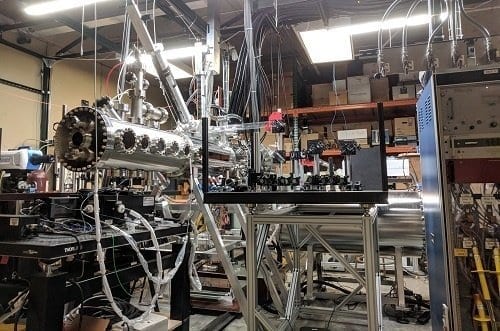
New research has provided a comprehensive overview of new small-scale nuclear reactors, which could be suitable candidates to cope with the world’s ever growing demand for energy.
A detailed assessment of a new, smaller type of nuclear reactor has been published to help policymakers decide on the best way to meet the growing demand for energy.
According to official estimates world energy consumption in 2035 will be more than double that of 1995. A substantial challenge for engineers and scientists over the coming decades is to develop and deploy power plants with sufficient capacity and flexibility to meet this increasing need while simultaneously reducing emissions.
The new research paper, published in the academic journal Progress in Nuclear Energy, aims to show to what extent a new type of nuclear reactor, termed the ‘Small Modular Reactor’ (SMR), might provide a solution to fulfil these energy needs.
Modern SMRs are a relatively ‘new product’ in the nuclear industry, being of a smaller size making it easier to implement new technical solutions and for construction purposes.
Lead author Dr Giorgio Locatelli, from the School of Engineering, University of Lincoln, UK, provides a state-of-the-art appraisal of SMRs, particularly focussing on the Light Water Reactor (LWR), detailing the economic and social limitations for their viable deployment.
Dr Locatelli said: “With fusion-based power plants not currently being considered viable for large-scale deployment for at least 40 years, other technologies must to be considered. Renewable and high efficiency combined gas-fired plants, along with nuclear power plants, are regarded as the most suitable candidates, with Small Modular Reactors (SMRs) developing as a favoured choice.
“Given the extreme relevance and complexity of the field, this paper aimed to bring together the contributions of scholars and practitioners with state-of-the-art papers and reports.”
One of the main issues surrounding nuclear power is safety, particularly following the Fukushima accident.
The simplification, standardisation and compactness of SMRs allows for certain improvements on reactor safety and physical protection, although these are design specific. These improvements are primarily due to SMRs being “passive systems” that dramatically reduce the effects of human error and perform well and predictably in extreme circumstances.
Their small size makes them a good option for locations that cannot accommodate large-scale plants and they also require limited upfront capital investment.
The Latest on: Nuclear reactors
[google_news title=”” keyword=”Nuclear reactors” num_posts=”10″ blurb_length=”0″ show_thumb=”left”]
via Google News
The Latest on: Nuclear reactors
- US, Philippines To Train Filipinos In Nuclear Poweron May 21, 2024 at 2:15 am
The Philippines and the United States agreed Tuesday to train Filipinos how to build and operate nuclear power plants, as the Southeast Asian country seeks to boost its electricity supply.
- Rolls-Royce and Sheffield University to test mini nuclear reactors in UKon May 21, 2024 at 1:41 am
The facility will focus on producing working prototypes of modules for assembly into Rolls-Royce SMR power plants.
- France open to UAE investments in nuclear industry, minister sayson May 21, 2024 at 1:36 am
France is open to the United Arab Emirates investing in its nuclear energy industry, its finance minister said on Tuesday, ahead of discussions in the Gulf state with UAE officials.Sources told ...
- IAEA-Led Review Validates Thailand's Progress in Research Reactor Infrastructure Developmenton May 21, 2024 at 1:08 am
Conducted from April 29 to May 3, the follow-up mission assessed Thailand's preparedness based on recommendations made during the initial INIR-RR mission in 2021.
- Nuclear-free councils hit out at ‘mad delusion’ of new reactoron May 20, 2024 at 11:20 pm
Calls for a nuclear revival in Scotland – including the possibility of a new Dounreay reactor – have been dismissed as “folly” and a “mad delusion”.
- Commissioning of Russia's 120MW Nuclear Icebreaker Postponedon May 20, 2024 at 3:53 pm
Russia is pushing back the commissioning of its planned 120 megawatt (MW) icebreakers, according to media reports.First Deputy ...
- Texas A&M System joins Texas Nuclear Alliance as founding member, first university memberon May 20, 2024 at 10:30 am
The Texas A&M University System has joined the Texas Nuclear Alliance as a founding member and the Alliance’s first university system member.
- Rolls-Royce signs £15m deal to test mini-nuclear reactors in Sheffieldon May 20, 2024 at 5:16 am
Rolls-Royce has signed a £15m deal with Sheffield University to trial manufacturing techniques for small modular reactors (SMRs), in the latest step towards making cheap nuclear power a reality.
- Nuclear subs are coming to Australia. Now the Coalition wants reactors, too. We’re not ready for iton May 16, 2024 at 5:55 pm
For decades, Australia has sold uranium – but said no to nuclear reactors. That’s set to change, whether in nuclear submarines or even in plans for power plants.
- US to Start $3.4 Billion Buy-Up of Domestic Nuclear Reactor Fuelon May 16, 2024 at 12:48 pm
The US will ask suppliers next month to bid on contracts for as much as $3.4 billion of domestically produced nuclear reactor fuel, according to a government notice.
via Bing News











